IL-23 mediates inflammatory responses to mucoid Pseudomonas aeruginosa lung infection in mice
- PMID: 17071720
- PMCID: PMC2841977
- DOI: 10.1152/ajplung.00312.2006
IL-23 mediates inflammatory responses to mucoid Pseudomonas aeruginosa lung infection in mice
Abstract
Patients with cystic fibrosis (CF) develop chronic Pseudomonas aeruginosa lung infection with mucoid strains of P. aeruginosa; these infections cause significant morbidity. The immunological response in these infections is characterized by an influx of neutrophils to the lung and subsequent lung damage over time; however, the underlying mediators to this response are not well understood. We recently reported that IL-23 and IL-17 were elevated in the sputum of patients with CF who were actively infected with P. aeruginosa; however, the importance of IL-23 and IL-17 in mediating this inflammation was unclear. To understand the role that IL-23 plays in initiating airway inflammation in response to P. aeruginosa, IL-23p19(-/-) (IL-23 deficient) and wild-type (WT) mice were challenged with agarose beads containing a clinical, mucoid isolate of P. aeruginosa. Levels of proinflammatory cytokines, chemokines, bacterial dissemination, and inflammatory infiltrates were measured. IL-23-deficient mice had significantly lower induction of IL-17, keratinocyte-derived chemokine (KC), and IL-6, decreased bronchoalveolar lavage (BAL) neutrophils, metalloproteinase-9 (MMP-9), and reduced airway inflammation than WT mice. Despite the reduced level of inflammation in IL-23p19(-/-) mice, there were no differences in the induction of TNF and interferon-gamma or in bacterial dissemination between the two groups. This study demonstrates that IL-23 plays a critical role in generating airway inflammation observed in mucoid P. aeruginosa infection and suggests that IL-23 could be a potential target for immunotherapy to treat airway inflammation in CF.
Figures
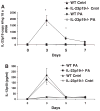

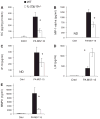


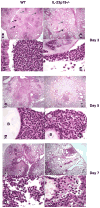
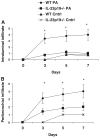
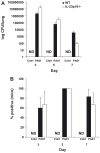
References
-
- Aggarwal S, Ghilardi N, Xie MH, de Sauvage FJ, Gurney AL. Interleukin-23 promotes a distinct CD4 T cell activation state characterized by the production of interleukin-17. J Biol Chem. 2003;278:1910–1914. - PubMed
-
- Armstrong DS, Hook SM, Jamsen KM, Nixon GM, Carzino R, Carlin JB, Robertson CF, Grimwood K. Lower airway inflammation in infants with cystic fibrosis detected by newborn screening. Pediatr Pulmonol. 2005;40:500–510. - PubMed
-
- Bonfield TL, Panuska JR, Konstan MW, Hilliard KA, Hilliard JB, Ghnaim H, Berger M. Inflammatory cytokines in cystic fibrosis lungs. Am J Respir Crit Care Med. 1995;152:2111–2118. - PubMed
-
- Brauner A, Cryz SJ, Granstrom M, Hanson HS, Lofstrand L, Strandvik B, Wretlind B. Immunoglobulin G antibodies to Pseudomonas aeruginosa lipopolysaccharides and exotoxin A in patients with cystic fibrosis or bacteremia. Eur J Clin Microbiol Infect Dis. 1993;12:430–436. - PubMed
-
- Carpagnano GE, Barnes PJ, Geddes DM, Hodson ME, Kharitonov SA. Increased leukotriene B4 and interleukin-6 in exhaled breath condensate in cystic fibrosis. Am J Respir Crit Care Med. 2003;167:1109–1112. - PubMed
Publication types
MeSH terms
Substances
Grants and funding
LinkOut - more resources
Full Text Sources
Miscellaneous

